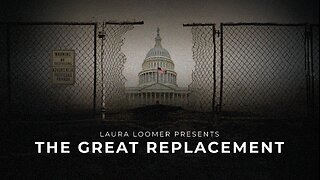Premium Only Content

New Biologic Age Clock Revealed by Dr. Varun Dwaraka
In this video, Dr. Sanjeev Goel and Dr. Varun Dwaraka, Head of Bioinformatics at TruDiagnostic, discuss biologic age testing, focusing on DNA methylation and epigenetics.
📚 PURCHASE DR. SANJEEV GOEL'S BOOK "The Top 10 Must Do Peak Human Biohacks of 2023"📚
→ iBooks: https://books.apple.com/ca/book/top-10-must-do-peak-human-biohacks-of-2023/id6448680046
→ Kobo: https://www.kobo.com/ca/en/ebook/the-top-10-must-do-peak-human-biohacks-of-2023
→ Amazon - https://www.amazon.com/dp/B0C1J2N1YF
📚 Purchase the Peak Longevity Prediction Pack 📚
→ https://peakhuman.ca/product/peak-longevity-pack/?v=3e8d115eb4b3
********************
Visit our website: https://peakhuman.ca/?v=3e8d115eb4b3
Shop here: https://peakhuman.ca/shop/
SUBSCRIBE TODAY: https://bit.ly/PeakHumanLabs
They explore how epigenetic changes occur with aging, affecting gene expression. The conversation touches on the history of epigenetic clocks, aiming to predict biological age beyond chronological age. They introduce the DunedinPACE Clock, which shows promise in improving accuracy. TruDiagnostic's OM Clock integrates various data layers, providing a comprehensive aging assessment. It predicts health outcomes with higher sensitivity and specificity than existing clocks and undergoes ongoing research for response to interventions. For more details, visit www.trudiagnostic.com or connect with Dr. Varun Dwaraka on LinkedIn or Instagram.
Varun Dwaraka PhD is the Head of Bioinformatics at TruDiagnostic, and an aging and longevity investigator specializing in epigenetics and bioinformatics. He has co-authored numerous publications relating to genetics, epigenetic clocks, DNA methylation, and tissue regeneration. In 2020, Dr. Dwaraka was elected as a full member to the Sigma Xi, The Scientific Research Honor Society, and currently serves as a 2023 Foresight Fellow in Biotechnology and Health Expansion, awarded by the Foresight Institute. He also serves on the Scientific Advisory Board for SRW Labs based in New Zealand, offering insight into the application and interpretation of epigenetic age biomarkers. Dr. Dwaraka is passionate about implementing machine learning methods to advance predictive medicine, identify novel biomarkers, and create algorithms to better understand the biology of aging.
******************
TIMESTAMP
0:00 - Intro
2:08 - Dr. Varun discusses the history of epigenetic clocks.
3:03 - Dr. Varun explains DNA methylation.
5:33 - Discussion about the effects of DNA methylation on gene expression.
8:24 - Dr. Varun talks about changes in methylation patterns with age.
9:00 - Introduction to Dr. Steven Horvath's work on epigenetic clocks.
10:14 - Dr. Horvath's role in the development of epigenetic clocks.
11:03 - The limitation of predicting chronological age accurately.
13:05 - DunedinPace Clock and its significance.
15:17 - Pace of Aging score.
15:33 - Explaining the concept of the Pace of Aging score.
16:10 - Describing the bounds of the Pace of Aging score.
17:00 - Question about the validity and frequency of the Pace of Aging score.
18:05 - Discussing how quickly the Pace of Aging score can change.
19:25 - Speculating on the reduced risk of mortality.
21:02 - Discussing variations in methylation patterns between tissues.
23:11 - Mention of the commonality and differences between aging clocks.
24:04 - Comparison of shared CpGs between different aging clocks.
25:26 - Discussion of differences in CpGs selected by different clocks.
26:06 - Question about similarities in aging CpGs across different species.
27:00 - Mention of a mammal clock that is conserved across species.
28:25 - Introduction to the development of the Omic Clock by True Diagnostic.
29:57 - Partnership with Brigham and Women's Hospital for data collection.
30:14 - Idea of combining different layers for a multi-omic inferred clock.
31:22 - Elastic net regression to identify relevant phenotypes.
31:49 - Training to predict time until death.
32:21 - Identification of factors associated with increasing EMR age.
33:03 - Incorporating additional data such as proteins, clinical values, and metabolites.
33:57 - Mention of generating EMR age.
34:03 - Integration of various data types into the clock.
35:00 - Creation of models to predict proteins, clinical values, and metabolites.
36:02 - Reducing the number of models to focus on relevant features.
37:01 - Explanation of correlation and filtering based on correlation values.
38:01 - Introduction of the "omic age" and its importance.
39:36 - Discussion of the omic age and its association with diseases.
40:00 - Explanation of odds ratios and their significance.
42:15 - Comparison of different clocks in terms of sensitivity and specificity.
43:05 - Mention of future testing of interventions on omic age.
#Epigenetics #BiologicAgeClock #Aging
-
 57:00
57:00
PMG
13 hours ago $0.47 earned"Terror Attacks or False Flags? IT DOESN'T ADD UP!!!"
12.4K3 -
 1:14:42
1:14:42
Anthony Rogers
10 hours agoThoughts on the L.A. Fires
32.4K8 -
 2:37:32
2:37:32
Kim Iversen
9 hours agoTerrorism, Act of God or “Newscum” Incompetence: What REALLY Fueled The California Wildfires
56.4K150 -
 2:16:33
2:16:33
Tucker Carlson
7 hours agoTucker Carlson and Michael Shellenberger Break Down the California Fires
210K306 -
 58:50
58:50
Laura Loomer
5 hours agoThe Great Replacement (Full-Length Documentary)
34.2K27 -
 LIVE
LIVE
Razeo
6 hours agoEp 31: Finishing March Ridge & onto Muldraugh tonight
471 watching -
 1:00:37
1:00:37
Adam Does Movies
4 hours ago $3.53 earnedBatman II Update + Flash Director Fails + Movie Bombs! - LIVE!
40.5K5 -
 2:26:24
2:26:24
We Like Shooting
19 hours ago $1.18 earnedWe Like Shooting 593 (Gun Podcast)
27.3K -
 57:03
57:03
Flyover Conservatives
1 day agoJack Hibbs Blasts California Leaders: Must-Watch!; Can Trump Fix the Mess? How Long will it Take? - Dr. Kirk Elliott | FOC Show
51.1K7 -
 2:00:50
2:00:50
DillyDillerson
5 hours agoTalking to the moon!! Just some live views of the FULL MOON!!
32.2K11